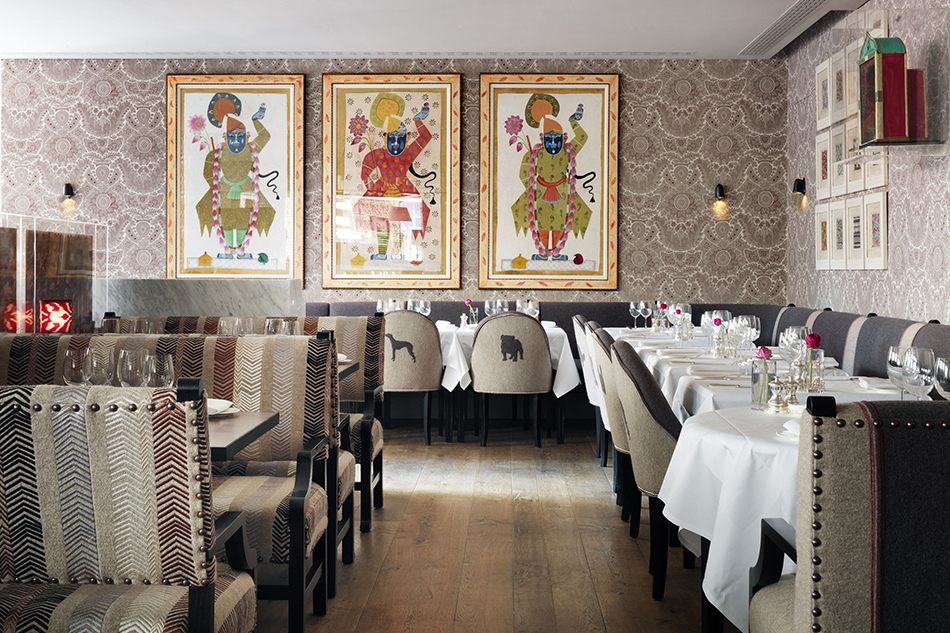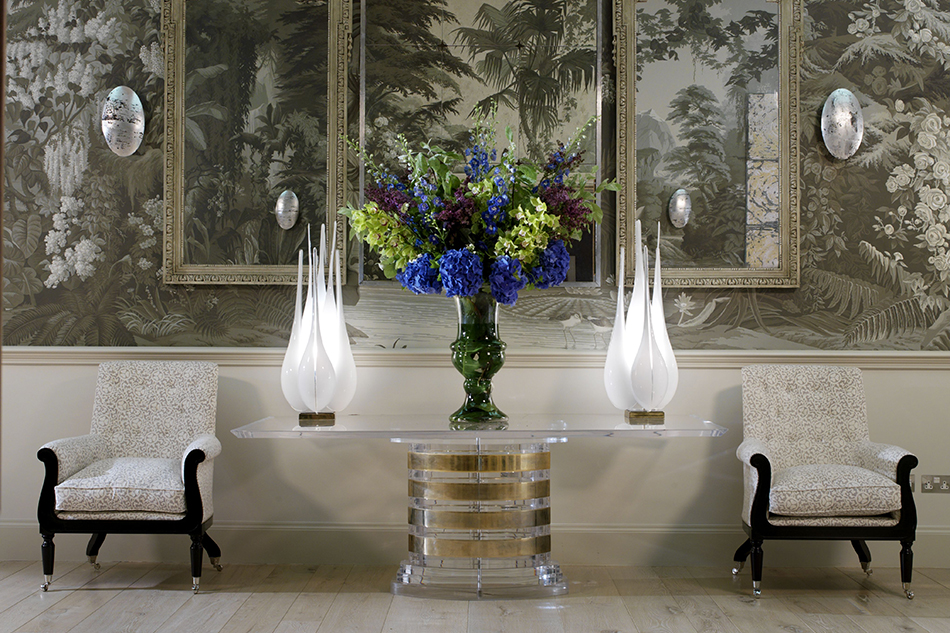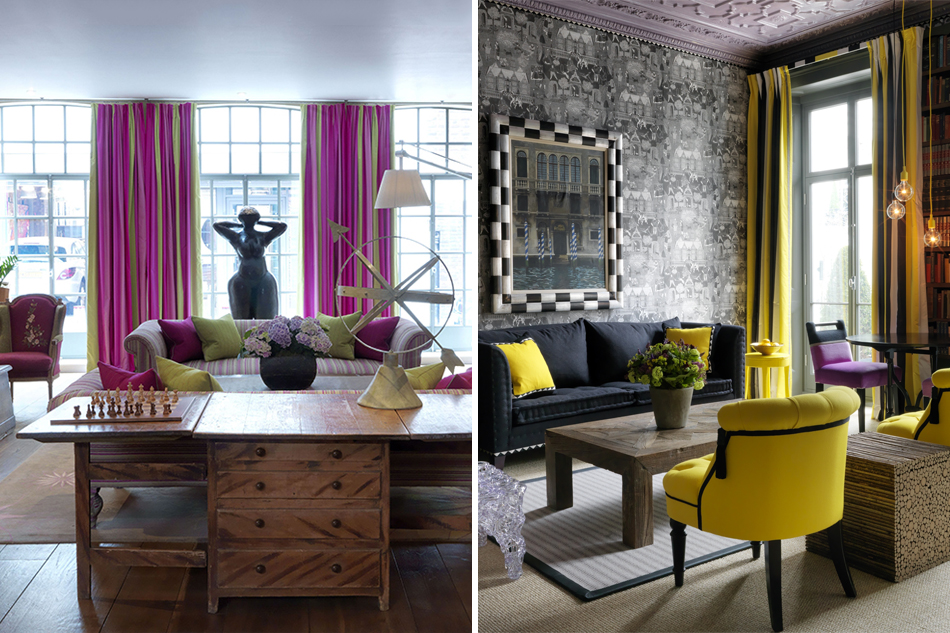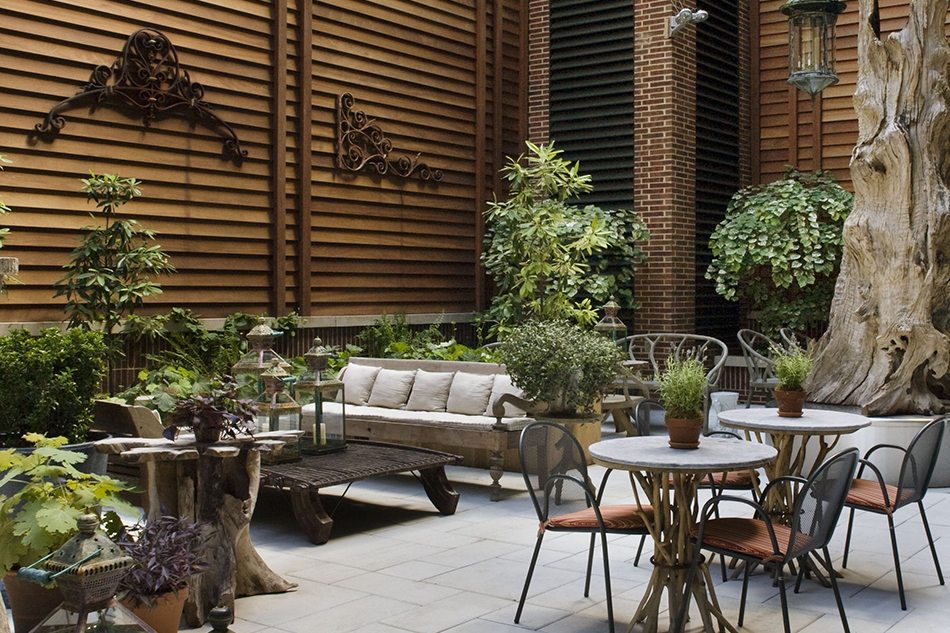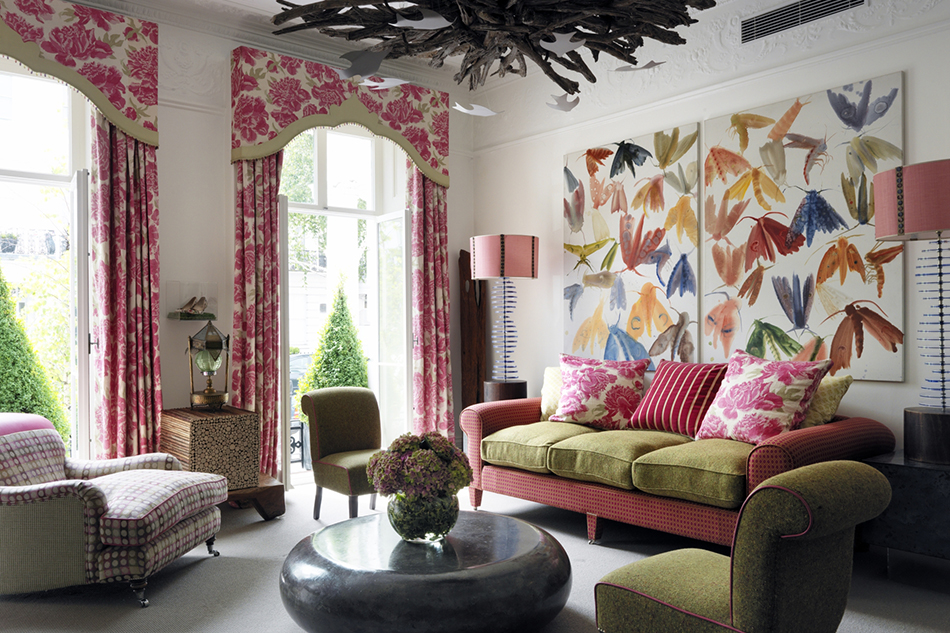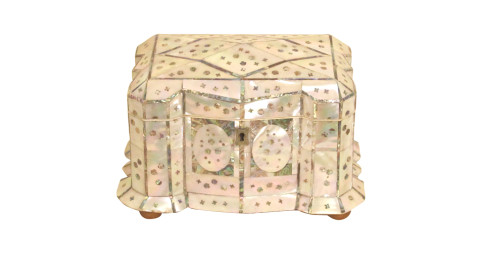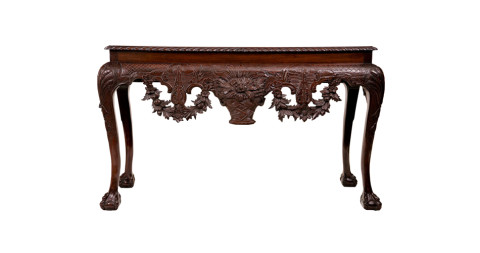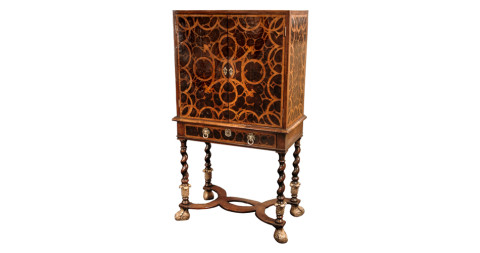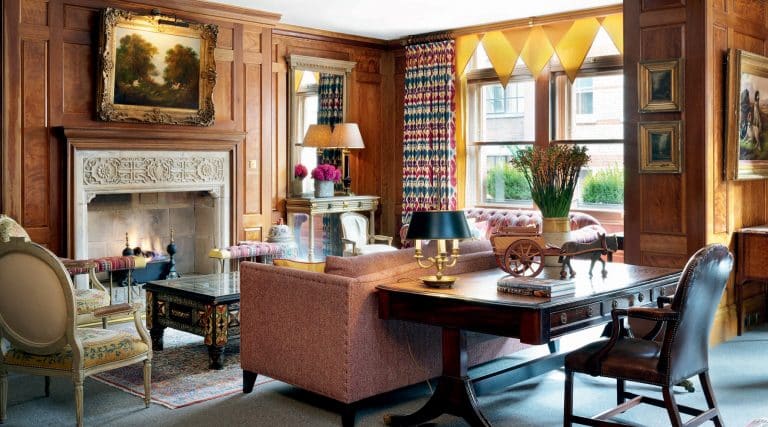
May 22, 2013A love of color and contemporary art, as well as an aesthetic combining whimsy and sophistication, define the interiors of Kit Kemp’s Firmdale hotels. Top: In the Sitting Room of New York’s Crosby Street Hotel, Kemp built up layers of texture with Bennison linens, Mulberry paisleys and Etro tweeds. All photos by Simon Brown
I am sitting in the Brumus restaurant of the Haymarket Hotel, close to London’s Piccadilly Circus, cocooned in the room’s dove grays, ruby reds and hot pinks. Across the table is Kit Kemp, co-founder and design director of the Firmdale hotel group, to which the Haymarket belongs — along with six others in London and one, the Crosby Street Hotel, in New York — and right now, at my request, she is deconstructing the entire room.
“I had the ornate legs on some of the dining tables copied in India from an antique piece I had acquired — the original was probably French nineteen-twenties,” she says. “The chairs are covered in boiled wool with embroidered dog motifs — I am very proud of the inside-out stitching we specified — and each banquette is trimmed in red. The vintage perforated umbrella lights came originally from a brasserie in France, while the wonderful illustrations behind you are by Louis Laing, who probably produced them as textile designs in the nineteen-forties. The herringbone fabric on the banquette is my own design, called Book End, while the columns are also covered in one of my designs, Willow. The Indian artwork in the Perspex boxes is actually an old storyboard from Udaipur. And our second daughter, Willow, produced the double-sided painting on wood.” There is a pause as a look of annoyance crosses her face. “And there should be a lamp here,” she gestures behind her. “But for some reason, it has been moved.”
Kemp’s recitation makes for a rather impressive performance — as does her aesthetic leadership of Firmdale’s overall portfolio, which, all told, includes six restaurants, 461 bedrooms and four fully-serviced short-stay apartments. There’s no doubt Kemp could have given me a detailed decorating tour of each and every room, so wedded is she to her work. (I’m also certain she’ll locate that missing lamp the moment we have finished our lunch.)

The lemon-hued lobby of London’s Haymarket Hotel offers a sunny welcome.
Petite, pretty and blonde, with a girlish laugh and well-mannered charm, Kemp is like a graceful swan floating across a lake — one whose legs must be furiously paddling beneath the surface. Last year, she was awarded an MBE (Member of the Order of the British Empire) for services to the hotel industry, an honor bestowed by the Queen — and an accolade like that isn’t given for lack of hard work.
And 2012 also saw the release of her first book, A Living Space (Hardie Grant), in which she combined lively commentary on the many inspirations that have fueled her particular look with plenty of lush images to satiate the many fans of her eclectic and comfortable style.
Today, Kemp would have me believe, it is her entrepreneurial husband and Firmdale co-founder, Tim, who’s the true workaholic: “I would never have seen him had I not gotten involved,” she insists. But one suspects they are equally driven, forging ahead in their parallel roles — he the hard-headed business force and she the equally formidable creative lead.
The couple met more than 30 years ago, introduced by an architect friend. Born and raised in leafy Hampshire, about 30 miles from London, Kemp went straight to work at age 18. After a first job at an auction house, she held a series of positions in the shipping industry, which led her to start a small company that produced yacht brochures. Tim, meanwhile, had been dipping his toes into real estate.

Natural daylight pours into the aptly named Conservatory dining room at Number Sixteen.
The couple married in 1983 and entered the hotel business soon after, almost by accident and with neither of them knowing much about it. Tim had taken a short lease on a building in Onslow Gardens, an area close to South Kensington that’s now a chichi address but back then was far less desirable. He had the idea of linking it to Richmond, the American International University, and providing two-star budget accommodation for the burgeoning student market. “It was about twelve pounds per night,” Kit recalls, “with most students sharing a room, but it was enormous fun for us and proved to be a hit commercially.”
Bolstered by their success, the Kemps subsequently opened the 37-room Dorset Square Hotel, in Marylebone. They were still only in their late 20s, but as she says, “When you are young, you are fearless. It was hard to get the banks interested, but you are so arrogant at that age, you don’t accept someone telling you that you can’t do something.” Their mission was simple: to open a hotel that they would like staying in themselves — something individual rather than formulaic.
It is testament to their characters that they have never lost sight of this vision. Today, every Firmdale property still has its own unique personality, from the paneled calm of the Covent Garden Hotel to the witty cool of the Soho Hotel. But if you look closely at each one, you can see how Kemp’s belief in the “Six Senses of Design” (sight, sound, smell, taste, touch and fun, as she delineates in her book) combine to create rich, warm, cozy and quirky spaces. Kemp continues to envision and create the schemes in every comfortable, inviting room, filling the fabulous buildings in brilliant locations that Tim manages to procure. “When you arrive at a hotel feeling tired and jaded, it should pique your curiosity and feel like a wonderful adventure,” says Kemp. “You should want to ring up your friends and say, ‘Guess where I am staying!’”

The Covent Garden Hotel, named for the London neighborhood in which it’s located, is favored by the fashion and creative set.
Kemp doesn’t do mass-produced or off-the-shelf; instead she fills warehouse upon warehouse with wonderful furniture, lighting, artwork and objects sourced from around the world. She then adds her own fabrics and rugs (produced by Christopher Farr) and embroidered textiles (produced by Chelsea Textiles) to the mix.
Also something of an eco-warrior, Kemp has garnered LEED Gold certification for the Crosby Street Hotel, which is arguably the greenest hotel in the state of New York. “Before Crosby Street, green initiatives were at the back of our minds, but now they are at the forefront, something we build into the design with each new project,” she says. She credits her three 20-something daughters with this change of emphasis. “I took them to Hong Kong, and when they saw the view out of the window at night for the first time, they said, ‘What a terrible waste of energy.’ From then on, I started to look at things differently.”
All these passions and distinctions aside, it is Kemp’s sense of color that most sets her apart from her fellow English decorators, whose palates tend to fall into one of two categories: muted shades of shabby chic or cool neutrals of classic contemporary. Kemp, in contrast, has an absolute passion for vivid, jewel-like tones — and she knows exactly where the boundary lies between gorgeous and garish. She plays with heaps of the hot pinks, reds and oranges found in India, but tones them down with neutrals like dove gray and oyster. “I have always loved the freshness of American interiors,” she explains. “British ones can feel rather dull and stodgy if you’re not careful. I loved sewing as a child, because I adored the bright colors of my mother’s embroidery threads. I suppose what I try to achieve in my designs is something that feels carefree — and you can’t do that without color.”
She now heads up a studio of nine, not only responsible for designing each hotel, but for keeping them refreshed and relevant. “That is an art in itself,” she admits, “because you can’t shut the whole hotel down every time you want to change something.”

Kemp and her husband, Tim, represent the ideal yin and yang — she the creative and he the business — sides of a partnership.
When I ask Kemp if Tim ever comes home and says, “Darling, I bought another hotel today,” with no word of warning, she replies: “Oh yes, that absolutely has happened. And my first reaction is usually, ‘No more, please!’ But Tim sees the project and then the result and nothing at all in between.”
Right now, most of her creative energies are going into the Ham Yard project in London’s Soho, due to open in 2014, which features not only a hotel, apartments and a restaurant, but a theater, bowling alley and potpourri of artisanal shops. “So much to play with!” she laughs. Meanwhile, a second New York hotel, located on 56th Street, is slated for 2015.
These days, the Kemps split their weeks between their Kensington townhouse and a Hampshire country home, about an hour from London. There, Kemp rides her horse, Lontaire, through the idyllic beauty of the New Forest, decompressing further by gardening, reading and practicing yoga. What she surrounds herself with in her homes is not so different from what guests enjoy in her hotels. “I am not interested in having a home that looks like a showhouse,” she says. “I don’t want to be surrounded by jaw-dropping, expensive objects and designer names. Rooms should not feel too labored or serious — they should look artless, even if a great deal of thought has gone into them.”

